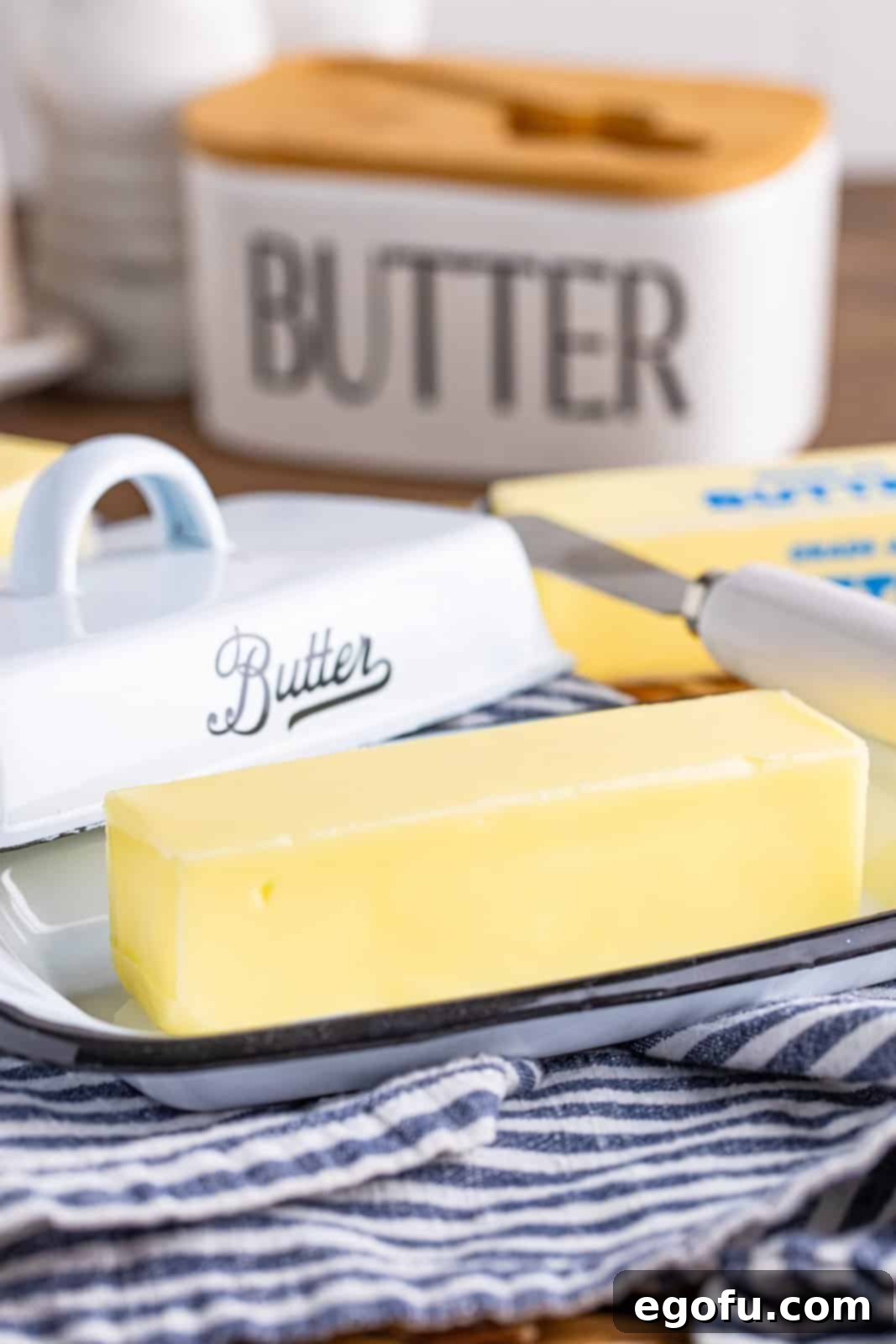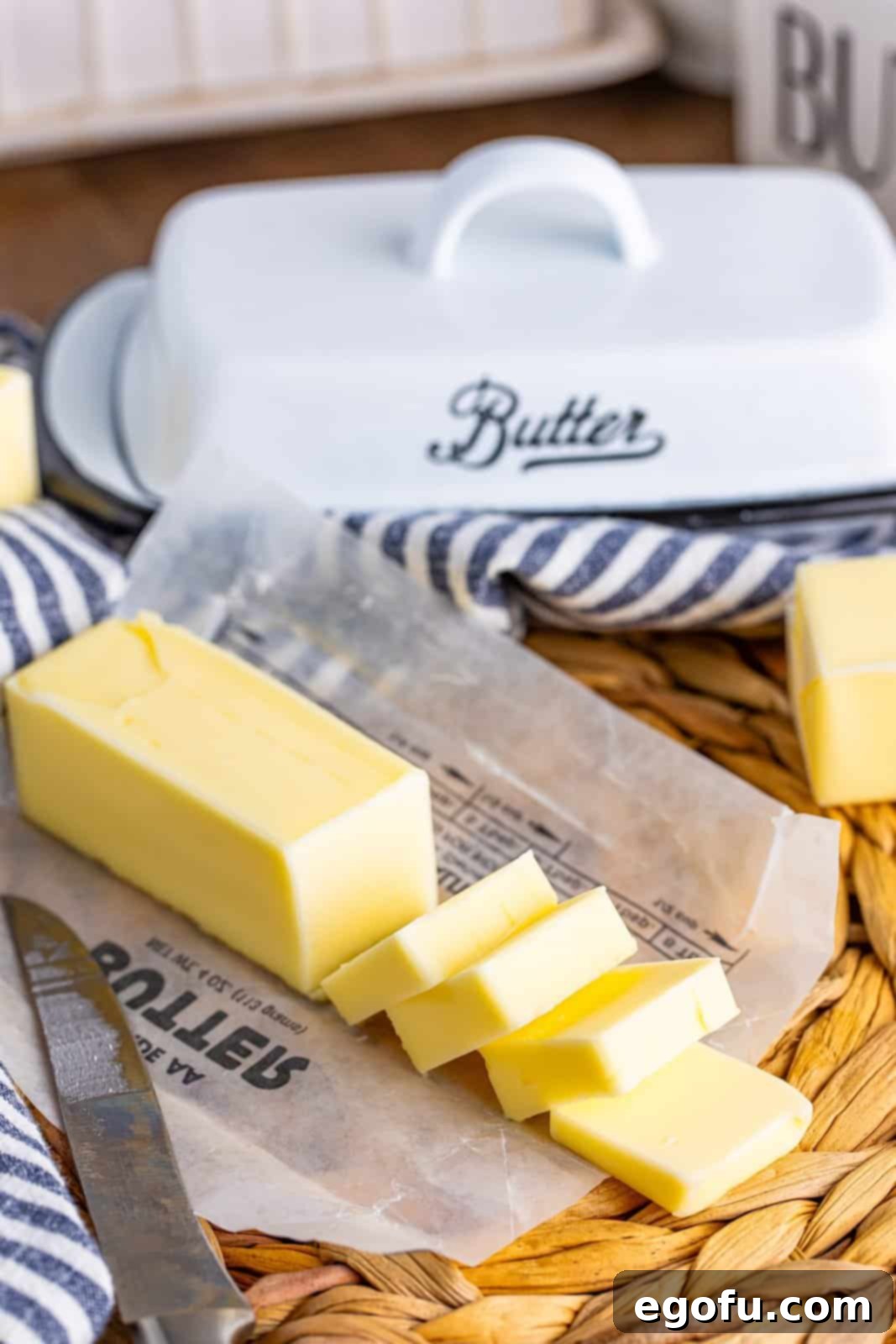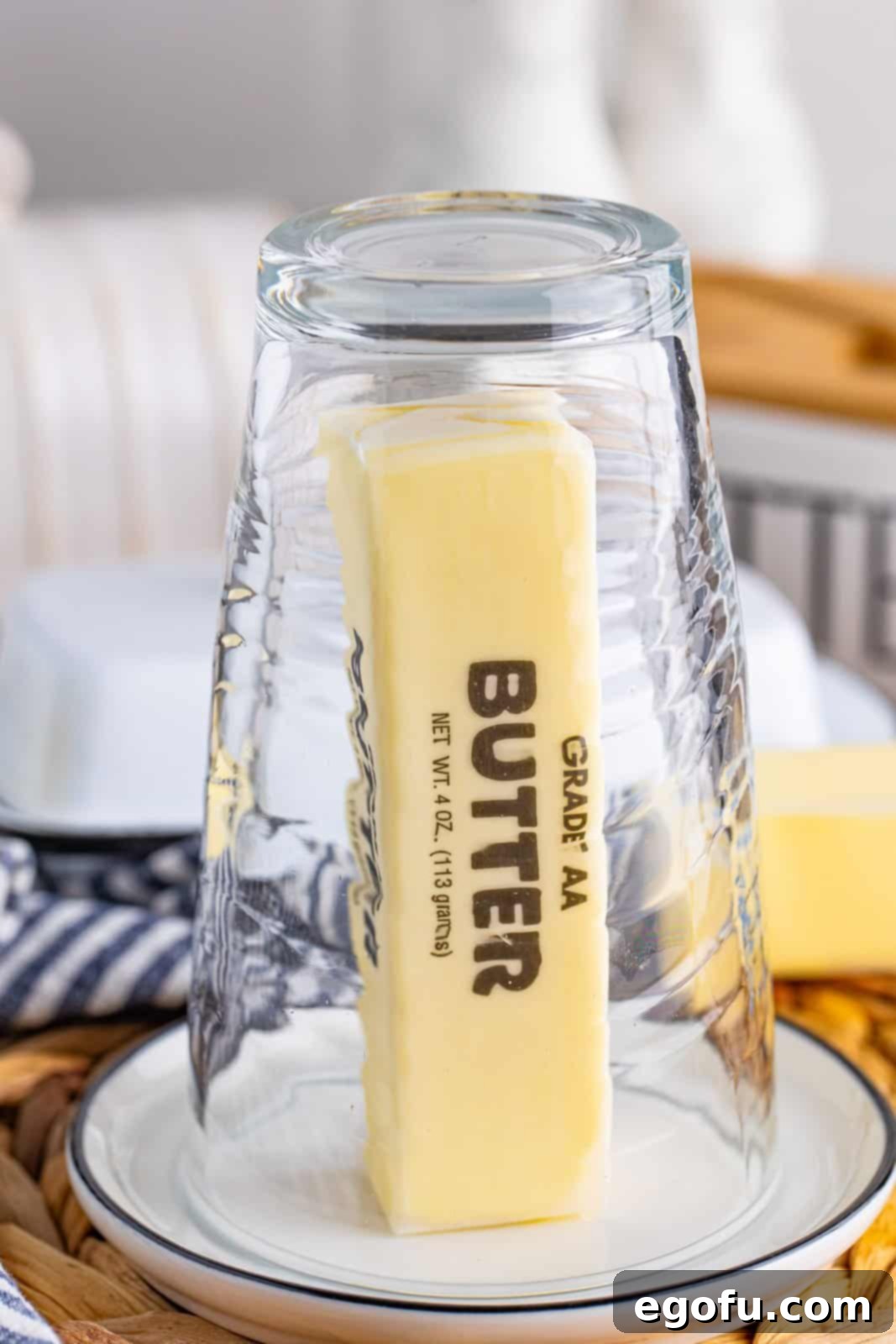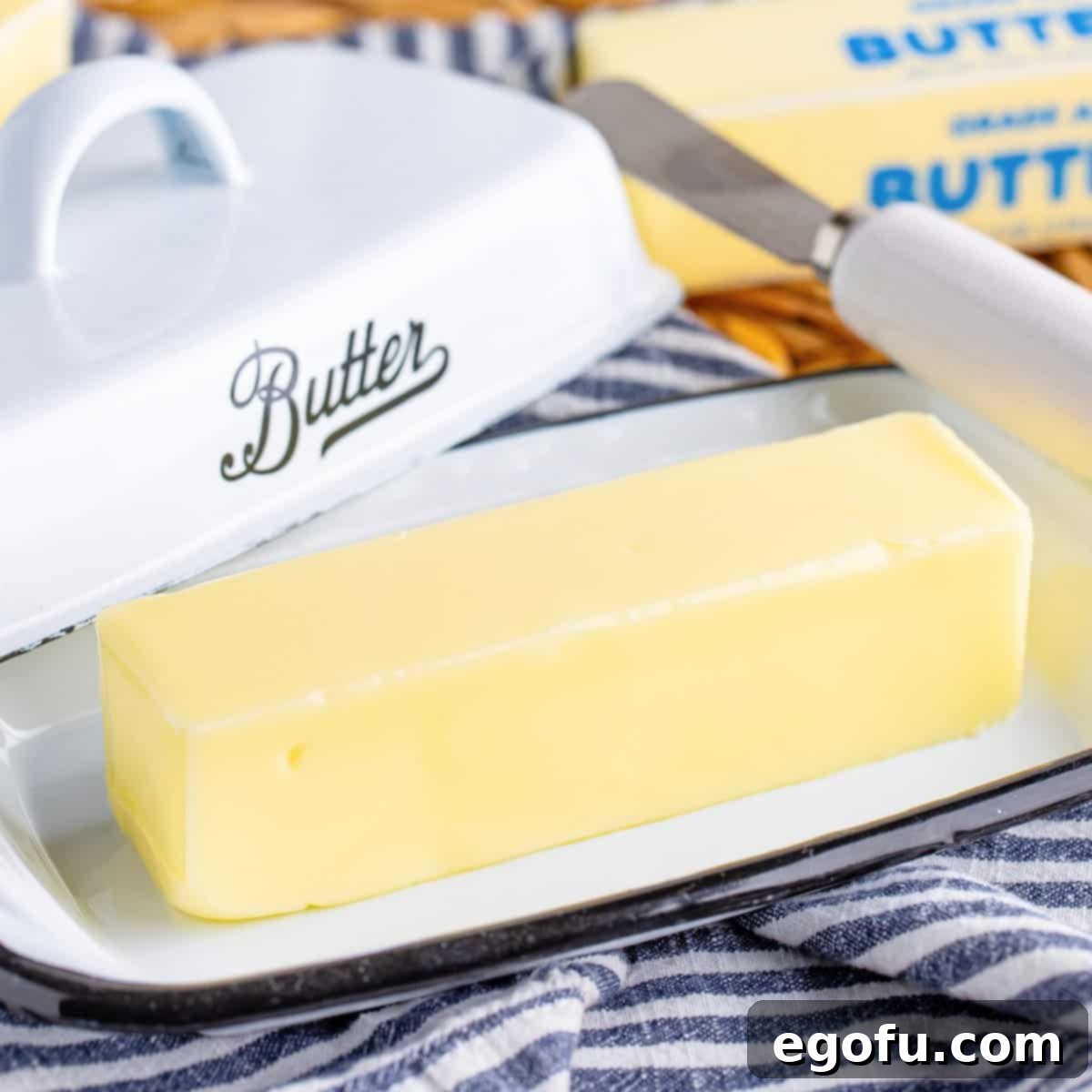Ever found yourself mid-recipe, only to realize your butter is rock-hard in the fridge? Don’t let a forgotten stick of butter derail your baking plans! This comprehensive guide reveals the most effective methods to soften butter quickly and perfectly, ensuring your culinary creations turn out flawless every time. Say goodbye to last-minute kitchen stress and hello to beautifully blended ingredients.
How to Soften Butter Quickly: Your Ultimate Guide for Baking Success
Achieving perfectly softened butter is a fundamental step in many baking recipes, from cookies and cakes to frostings and pastries. It’s a common scenario: you’re excited to start baking something delicious, you gather all your ingredients, and then that sinking feeling hits – the butter is straight from the refrigerator, firm and unyielding. Cold butter just won’t cut it for creaming with sugar or incorporating smoothly into doughs. Fortunately, a variety of techniques exist to bring butter to its ideal consistency, whether you have hours to spare or just a few minutes. In this detailed article, we’ll explore both traditional, patient approaches and ingenious quick hacks that will save your recipe and your day, allowing you to master the art of perfectly softened butter.

Why Perfectly Softened Butter Matters in Baking
Understanding why butter needs to be softened is crucial for any baker. When butter is at the right temperature, typically between 65-68°F (18-20°C), it achieves a specific consistency that significantly impacts the final texture and flavor of your baked goods. This ideal state allows butter to be easily creamed with sugar, a process where tiny air pockets are incorporated into the mixture. These air pockets are vital for creating a light, fluffy texture in cakes and cookies, giving them their characteristic rise and tender crumb. Cold butter, on the other hand, resists creaming, leading to dense, tough results. If butter is too warm or melted, it won’t hold air effectively, resulting in greasy baked goods that spread too much. Softened butter emulsifies better with other ingredients like eggs and liquids, creating a smooth, cohesive batter that bakes evenly. It’s the silent hero behind countless delicious treats, ensuring every bite is rich, tender, and perfectly textured.
Frequently Asked Questions About Softening Butter
The ultimate test for perfectly softened butter is simple: the finger test. Gently press your finger into the stick of butter. If it’s ready, your finger should easily make a slight indentation without much effort, but the butter should still hold its shape. It should feel pliable and creamy, not greasy or shiny like melted butter, nor hard and resistant like cold butter. There should be no liquid or melting around the edges. If your finger sinks in too easily or the butter looks oily, it’s likely too warm.

If your butter isn’t quite soft enough after using one of the methods, don’t fret. You can always continue with your chosen method, allowing it a few more minutes. Alternatively, if it’s just a little firm, whipping it with an electric hand mixer or in a stand mixer for a minute or two can help break it down and bring it to the desired creamy consistency. The mechanical action generates a small amount of heat and helps distribute it evenly. However, be cautious not to over-whip or let it become too warm, as this can introduce too much air or even start to melt it, which is undesirable.
If your butter accidentally becomes too soft or starts to melt, especially when using rapid methods, it’s best to chill it down slightly. Place the butter back in its wrapper or on a plate and refrigerate it for 5-10 minutes. Keep a close eye on it to ensure it firms up just enough without becoming rock hard again. While it won’t have the exact same crystalline structure as butter slowly softened at room temperature, chilling it can often salvage your baking project. For the best results, always aim for softened, not melted.
Essential Ingredient:
- A stick of butter (salted or unsalted, as per your recipe)
Effective Methods to Soften Butter Quickly and Safely
Now that we understand the importance of softened butter, let’s dive into various techniques to achieve it. We’ll cover both time-tested traditional approaches and ingenious speedy hacks for those moments when time is of the essence.
Traditional Methods for Softening Butter (Plan Ahead for Best Results)
These methods are ideal when you have ample time, ensuring the butter softens evenly and naturally, preserving its delicate structure and optimal baking properties. They typically involve bringing the butter to room temperature gradually.
Total time: 1-3 hours (depending on ambient temperature and butter size)
Let it sit at room temperature: The simplest approach
This is the gold standard for softening butter. Simply take the required amount of butter out of the refrigerator and place it on your kitchen counter. Depending on the temperature in your home, this can take anywhere from 1 to 3 hours. Cooler kitchens will require more time, while warmer rooms will speed up the process. You can leave it in its original packaging or unwrap it and place it on a plate. This slow, natural process allows the butter to soften uniformly without any risk of melting, resulting in the best possible texture for your baking.

Cut into cubes at room temperature: Speeding up the natural process
If you have about 30-60 minutes but not a full 2-3 hours, cutting your butter into smaller cubes is an excellent strategy. By increasing the surface area exposed to the ambient air, the butter will absorb heat more quickly and soften faster. Aim for cubes approximately 1/2 to 1 inch in size. Arrange the cubes in a single layer on a plate or cutting board to maximize air circulation around each piece. This method is a fantastic compromise between the leisurely room temperature approach and the rapid emergency hacks.

Thinly slice butter: Even faster than cubes
Taking the surface area concept a step further, thinly slicing your cold butter into small pats can drastically reduce the softening time at room temperature. Use a sharp knife to cut the butter into slices about 1/4 to 1/2 inch thick. Spread these slices out individually on a plate, ensuring none are overlapping. This maximizes their exposure to the air, allowing them to come to the ideal temperature in about 20-30 minutes. It’s a slightly more active approach than just cubing, but it pays off with quicker results.

Rapid Butter Softening Techniques (When You’re in a Pinch)
Sometimes, planning ahead isn’t an option. These speedy methods are your go-to solutions for achieving soft butter in a fraction of the time, perfect for those unexpected baking urges or forgotten prep steps.
The Hot Water Glass Method: Our preferred quick method
Total Time: 15-20 minutes
This ingenious method uses residual heat to gently and effectively soften butter without the risk of melting. It’s our top recommendation for a quick solution:
- Select a tall glass or heat-proof bowl that can easily fit over your stick of butter.
- Fill the glass or bowl with very hot tap water (not boiling, just hot enough to create steam).
- Let the hot water sit in the glass/bowl for 3-5 minutes. This allows the glass to absorb and retain a significant amount of heat.
- Carefully pour out the hot water and quickly dry the inside of the glass to prevent water droplets from touching the butter.
- Immediately invert the warm glass/bowl over your stick of butter on a plate or cutting board. The trapped heat and steam will create a warm micro-environment around the butter.
The residual heat from the glass will gently warm the butter, softening it beautifully in approximately 10-15 minutes. This method is fantastic because it’s controlled and minimizes the risk of overheating and melting, providing a consistency very close to naturally softened butter.

Microwave Method: Use with extreme caution
Total Time: 15-30 seconds (plus or minus)
While the microwave can soften butter in mere seconds, it’s a method that requires extreme caution due to the high risk of melting or uneven heating. It should be considered a last resort. If you choose this method, follow these steps carefully:
- Remove all wrapping from the stick of butter and place it on a microwave-safe plate or bowl.
- Microwave the butter on the lowest power setting (often defrost or 10-20% power) for very short intervals, typically 5-10 seconds at a time.
- After each interval, remove the butter and gently press it with your finger to check its softness.
- Flip the butter over between intervals to encourage more even softening.
The key is to stop microwaving as soon as it feels soft, but definitely before it starts to melt even slightly. Microwave ovens heat from the inside out, so the center might be melting while the outside still feels firm. Over-microwaved butter will become oily and lose its ability to cream properly, negatively impacting your baking.

The Rolling Pin Trick
This physical method is surprisingly effective for quick softening. Place the stick of butter between two sheets of parchment paper or wax paper. Using a rolling pin, gently but firmly roll over the butter, flattening it into a thin, even sheet. The pressure and friction from the rolling pin, combined with the increased surface area, will quickly bring the butter to a softened state. This method usually takes only a few minutes and is great for butter that needs to be incorporated into doughs.
The Grater Method
For almost instant gratification, grab a box grater! Simply grate the cold stick of butter into small shreds. These fine shreds have a massive surface area, allowing them to come to room temperature almost immediately. This method is particularly useful if you need softened butter for something like a quick frosting or a crumble topping. Just be careful with your fingers while grating!
Warm Water Bath (Sealed Bag Method)
Another gentle yet quick method involves a warm water bath. Cut your butter into a few chunks and place them in a sturdy, re-sealable plastic bag, pressing out as much air as possible. Submerge the sealed bag in a bowl of warm (not hot!) water. The warmth of the water will transfer to the butter through the bag, softening it in about 5-10 minutes. Ensure the bag is completely sealed to prevent water from entering and ruining the butter.
Tips for Butter Softening Success
- Start Early: Whenever possible, plan ahead and let butter soften naturally at room temperature.
- Consistency is Key: Always aim for butter that is soft enough to indent easily, but still holds its shape. Avoid melted or oily butter.
- Cut it Up: For any method, breaking the butter into smaller pieces (cubes, slices, shreds) will significantly reduce softening time.
- Avoid Direct Heat: Never place butter directly on a hot surface or in direct sun, as this will lead to uneven melting.
- Use Your Senses: Touch, sight, and even smell can help you determine if your butter is at the right consistency.
Want More Essential Kitchen Tips Like This One?
Mastering basic kitchen techniques is the secret to becoming a confident cook. Explore more helpful guides to elevate your culinary skills:
- How to Soften Cream Cheese Quickly
- How to Make Buttermilk
- How to Flash Freeze Food
- How to Convert Oven Recipes to Air Fryer Recipes
- How to Convert Air Fryer Recipes to Oven Recipes
- Homemade Velveeta
Conclusion
Never again let cold butter stand between you and your baking dreams! With these proven methods, you have all the knowledge to achieve perfectly softened butter every single time. Whether you prefer the patient approach of letting it sit at room temperature or need a speedy fix with the hot water glass method, you’re now equipped to handle any butter emergency. Incorporating these simple techniques into your baking routine will ensure your cookies are chewier, your cakes are fluffier, and your frostings are smoother. Happy baking!

How to Soften Butter Quickly
15
minutes
15
minutes
1
Brandie Skibinski
Ingredients
-
½
cup
(1 stick) butter
(salted or unsalted)
Instructions
Glass Method: Best quick method
- Pour very hot water into a glass or bowl that will fit over your stick of butter. Allow the hot water to sit in the glass/bowl for 3-5 minutes.
- Pour out the water and place the glass/bowl over the stick of butter. The residual heat from the hot water will speed up the process of softening the butter. It will soften in about 10-15 minutes.
Traditional Method: Let it sit at room temperature
- Depending on the temperature in your home, this can take anywhere from 1-3 hours. You can leave it in the packaging or open it.
- Cutting it into cubes will help speed up the process of allowing it to sit out at room temperature.
- Or you can thinly slice the butter to help speed up the process. Place the slices separately on a plate to help.
Microwave Method:
- Although this is not recommended, you can soften butter in the microwave, but you have to be extremely careful while doing so. Remove any wrapping and place on a microwave safe plate of bowl. Only microwave in 5-10 second intervals until soft but not melted.
How to
American
Nutrition
Calories:
814
kcal
|
Carbohydrates:
0.1
g
|
Protein:
1
g
|
Fat:
92
g
|
Sodium:
730
mg
|
Sugar:
0.1
g
Nutritional Disclaimer
“The Country Cook” is not a dietician or nutritionist, and any nutritional information shared is an estimate. If calorie count and other nutritional values are important to you, we recommend running the ingredients through whichever online nutritional calculator you prefer. Calories and other nutritional values can vary quite a bit depending on which brands were used.
Did you make this recipe?
Share it on Instagram @thecountrycook and mention us #thecountrycook!
